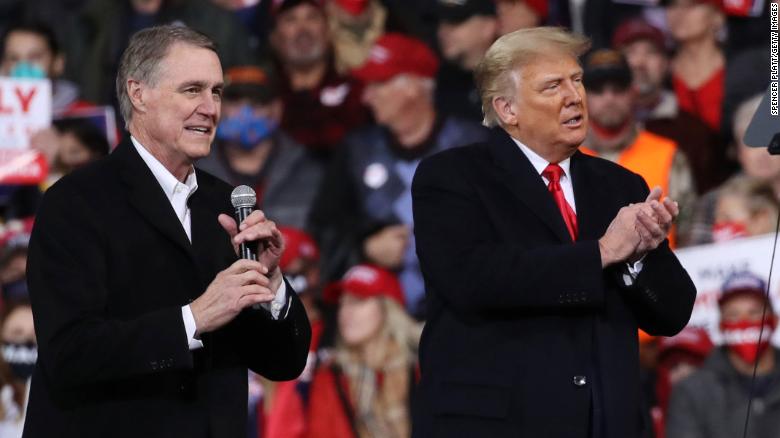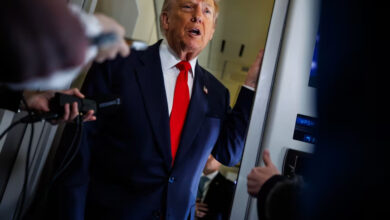
(CNN) – It’s now less than seven months until Election Day. May will see a slew of key primaries, and former President Donald Trump, who may be declaring a White House comeback bid by this time next year, has made several endorsements in those races, including backing Dr. Mehmet Oz’s Senate candidacy in Pennsylvania on Saturday.
And while plenty of Trump-endorsed candidates seem to be well on their way to winning their primaries, others have been struggling.
Last week, Trump acknowledged that his preferred candidate in Georgia’s gubernatorial race (former Sen. David Perdue) may not win.
Trump’s endorsement problem is where we begin our latest look at the numbers in the news.
Republicans still ‘like’ Trump, but ‘love’ is another question
Perdue is not the only example of a Republican candidate finding out that Trump may not have the Midas touch. In next-door Alabama, Trump actually withdrew his endorsement of US Rep. Mo Brooks in that state’s Senate race. Brooks’ problem? He was losing.
The fact is that the former President is not as popular among Republicans as he once was. The number of Republicans who love Trump has dropped precipitously since the 2020 election.
This is most evident when we look at Trump’s “very favorable” ratings among Republicans. When you hold a very favorable rating of a politician, you don’t just like them, you love them. Trump rode a relatively high very favorable rating to the GOP nomination in 2016, past a divided field, even as his overall favorable rating was rather weak.
Trump's endorsement power will be put to the test as May primaries approach
Trump’s endorsement power will be put to the test as May primaries approach
In an average of recent polls, Trump’s very favorable rating stood at 53 percent among Republicans. That’s certainly not bad, but it’s far from infallible. It means that roughly half the GOP base isn’t in love with Trump.
Trump’s very favorable rating on the eve of the 2020 election was 72 percent among Republicans. This corresponds to a 19-point decline in his very favorable rating since the election.
Part of what’s happening is that Trump’s overall favorable rating (“very favorable” combined with “somewhat favorable”) is lower. His favorable rating has dipped from 90 percent to 80 percent among Republicans. This drop though is about half the drop in Trump’s very favorable rating.
In other words, a larger share of pro-Trump Republicans today, as compared to a year and a half ago, like him instead of love him.
When you ask Republicans directly about the effect of a Trump endorsement, you come to a similar conclusion.
A January Quinnipiac University poll found that just 44 percent of likely Republican primary voters in Georgia said a Trump endorsement would make them more likely to vote for a candidate. Most said it made no difference (50 percent) or made them less likely (5 percent).
Keep in mind too that being “more likely” doesn’t mean people will switch their votes based on a Trump endorsement. It only means it increases the chances.
An average of national polls from ABC News/Washington Post and Fox indicates the same thing. Less than 50 percent of Republicans — 48 percent if you examine only Republicans or 44 percent if you include independents who lean Republican — say that a Trump endorsement would make them more likely to vote for a candidate.
To be clear, none of this means that going against Trump is wise politics in the modern GOP. Trump is still liked, and polling shows most Republicans are not fans of those who openly criticize the former President. Several House Republicans who voted to impeach him last year aren’t even running for reelection.
Rather, the takeaway from this polling is that Republican officials don’t have to bend over backwards to accede to every Trump demand. A Republican doesn’t have to be Trump’s favorite to win reelection. They just can’t be openly hostile to him.
Things aren’t groovy on the Democratic side
Another notable election tidbit this past week comes from a special election in California to fill out the remaining months of former US Rep. Devin Nunes’ term in Congress. You might have missed it because the district (California’s 22nd) will not exist in its current form come next Congress because of redistricting.
Yet, the special election is the latest indicator that the national environment heading into the 2022 midterms is quite different from the one we saw in 2018.
The California race featured four Republicans and two Democrats facing off in a jungle primary, with all candidates appearing on the same ballot. Given that no one appears to have received a majority of the vote, there will be a second round in June between the top-two finishers.
For the purposes of this analysis, the Republican candidates had as of Friday, with ballots still being counted, combined for 66 percent of the vote versus 34 percent for the Democratic candidates — a difference of 32 points. This represents a massive overperformance for Republicans compared to the 2020 presidential result in the district.
Trump carried the district by 5 points over now-President Joe Biden. The Republican candidates combined are doing 27 points better from 2020 right now.
Of course, the result from this one special election is one data point. A general rule for special elections is to look at as many of them as possible.
So far this cycle, in eight federal special elections, Republican candidates are outperforming the Trump 2020 baseline by an average of 6 points.
This is a big shift from what was happening during the 2018 cycle, when Republicans in federal special elections were underperforming the Trump 2016 baseline by an average of 12 points.
That 12-point underperformance foreshadowed the net loss of 40 House seats for the Republicans in the 2018 midterms.
Obviously, a 6-point overperformance for the GOP is less than what it was for the Democrats four years earlier. But it would be more than enough for the House to switch hands, if Republicans were able to replicate that throughout the nation in November. They came quite close to taking back the House in 2020, so any tilt of significance in their direction since then will give them the chamber.
Moreover, the special congressional elections is just one sign of a strong environment for Republicans this year. They’re ahead on the generic congressional ballot by about 3 points, which is 6 points better than their performance in the 2020 House elections. Biden’s approval rating is having a hard time moving much past 40 percent.
Unless something dramatically changes over the next seven months, Republicans will likely retake the House majority.
For your brief encounters: Baseball is no longer America’s game
Major League Baseball’s season kicked off Thursday. It was a footnote for most Americans — and even on ESPN’s website, where coverage of Tiger Woods and the Masters was the lead story.
This is part of the larger story of baseball’s decline, as I wrote in an in-depth column. Only 11 percent of Americans say baseball is their favorite sport. Among adults under 30, baseball is the fourth favorite sport to watch. That’s quite the turnaround from 1960, when baseball dominated, with over 30 percent of Americans telling pollsters it was their favorite sport to watch.
April 2 brief encounter: I pointed out that the 2021 women’s NCAA basketball final was well watched with 4.1 million viewers. The women’s final this year did even better with 4.9 million viewers. More people watched this year’s final than any since 2004.
Leftover polls
Crime and violence: The percentage of Americans concerned a great deal with crime and violence (53 percent) is tied for a 20-year high, according to Gallup. The percentage of Republicans concerned a great deal (61 percent) is the highest this century.
Russia: Americans have turned on Russia dramatically in the last few months. The vast majority (70 percent) now see the country as an enemy of America, while just 41 percent felt that way in January, according to Pew Research Center polling. Those who believe Russia is a competitor declined from 49 percent to 24 percent, while the percentage who see Russia as a partner went from 7 percent to 3 percent.
Climate change: Forty-three percent of Americans told Gallup that they worry a great deal about global warming or climate change. This is the same percentage as in 2018, though higher than the 30 percent who worried a great deal about it ten years ago, in 2012. There was a huge partisan divide, with 67 percent of Democrats worrying about it a great deal compared with 13 percent of Republicans.




